Ivy gourd, scientifically known as Coccinia grandis, is a tropical and subtropical vine that produces small, elongated fruits resembling miniature cucumbers. Also commonly referred to as "tindora," "gentleman's toes," or "baby watermelon," ivy gourd is cultivated for its edible fruits, leaves, and shoots.
What is the origin of the name “ivy gourd”?
“Ivy gourd” is a descriptive common name that reflects the characteristics of the plant.
The vine’s climbing growth habit, along with the presence of small gourd-like fruits, contributed to the naming of the plant as “ivy gourd.” The name helps people easily visualize and identify the plant based on its appearance.
What Other Names is Ivy Gourd Known By?
From the Cucurbitaceae family, the scientific name is Coccinia grandis. Because of its popularity in India and Ayurvedic medicine, it has multiple Indian names, including:
What Are You Foraging For Right Now?
We're thrilled to hear your ideas. What would you like to submit today? Feel free to share your thoughts and experiences with us.
- Kovakkai in Tamil
- Tendli in Marathi and Konkani
- Dondakaaya in Telugu
- Tindora in Hindi
- Kundru in Hindi
Other common names include:
- Little gourd
- Kowai fruit
- Baby watermelon
- Calabacita
- Thai spinach
- Scarlet gourd
How to Identify Ivy Gourd?
Here’s how to identify ivy gourd:
Vine
- Ivy gourd is a climbing vine that can grow vigorously. It often climbs on trellises, fences, or other supports.
- The vine produces tendrils that help it attach to structures as it climbs.
Leaves:
- Ivy gourd leaves are heart-shaped with prominent veins. They are green and may have a slightly glossy appearance.
- Leaves are usually alternate on the vine and have a distinct shape that makes them stand out.
Flowers:
- Ivy gourd produces small, white flowers with five petals. The flowers are star-shaped and have a central stamen with pollen-producing structures.
- Flowers are typically solitary or appear in small clusters.
Fruits:
- Ivy gourd fruits are small, elongated, and often green, although they can also be various shades of yellow or orange when ripe.
- The fruits have a slightly ribbed surface and are usually about 1 to 2 inches in length.
- When mature, the fruits are edible and used in cooking.

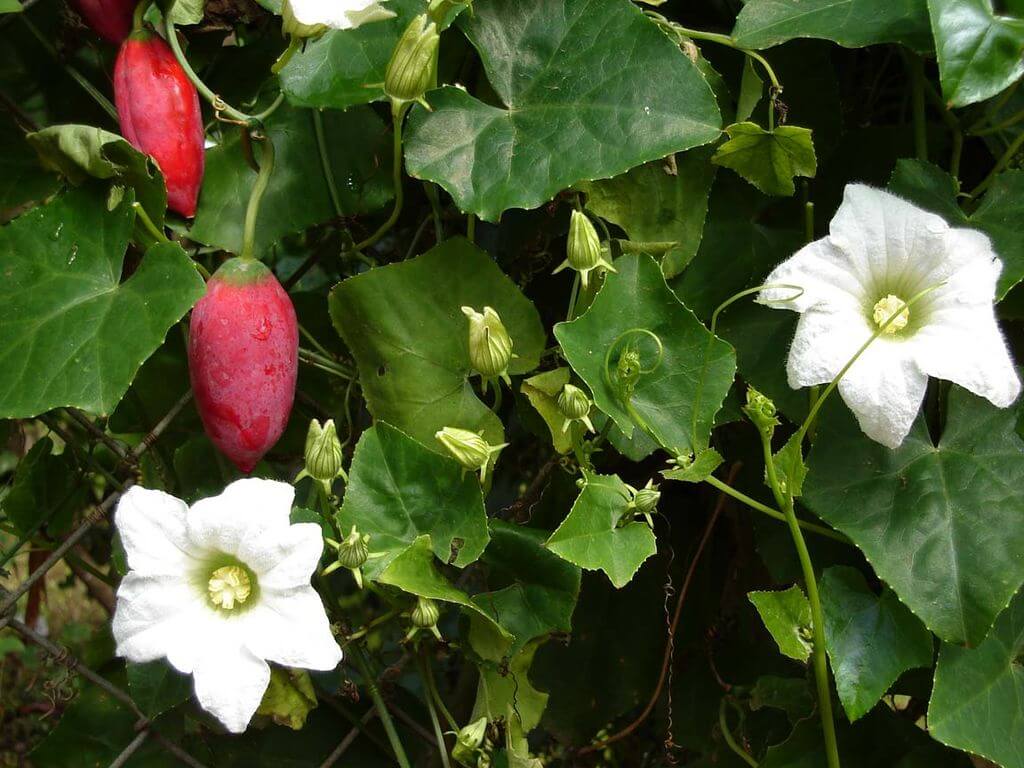
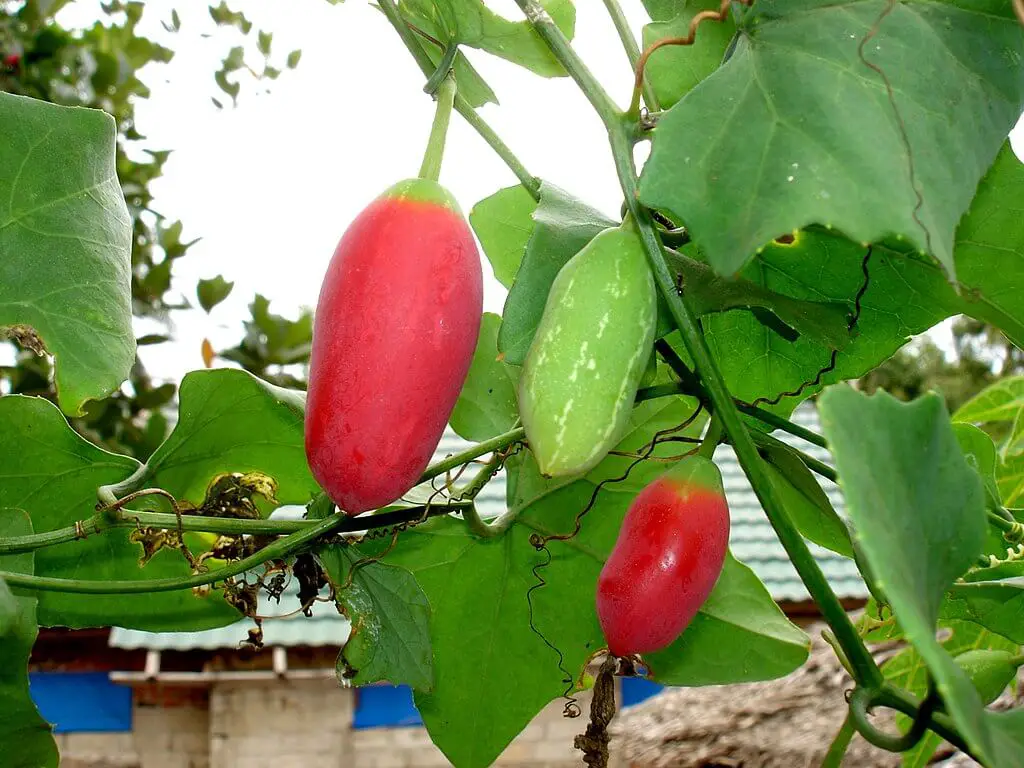
Is ivy gourd a type of squash?
Ivy gourd is often confused with squash due to its similar appearance and usage in cooking, but it is not a type of squash. Ivy gourd belongs to a different botanical family and genus.
It is a member of the Cucurbitaceae family, which includes cucumbers, melons, and pumpkins, among others. Squash, on the other hand, belongs to the Cucurbita genus within the same family.
What is the difference between a pumpkin and ivy gourd?
While both pumpkins and ivy gourd belong to the same botanical family (Cucurbitaceae), they are distinct plants with different appearances, uses, and culinary profiles.
Pumpkin plants are large, sprawling vines that produce large fruits. Ivy gourd plants are also vines, but they are typically smaller and produce smaller, elongated fruits.
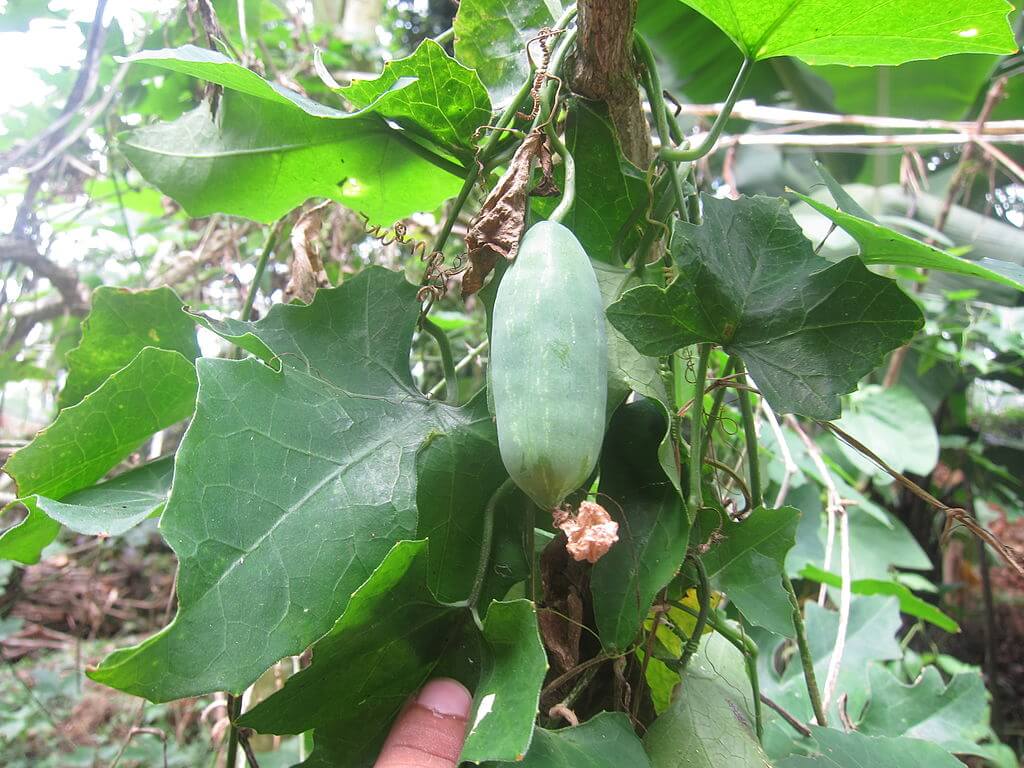

Other similar plants and fruits you may be interested in reading about include:
Where does ivy gourd grow?
Ivy gourd is native to tropical and subtropical regions of Africa and South East Asia. Ivy gourd has been introduced to some Caribbean islands and countries in Latin America as well.
There have been reports of ivy gourd being grown in certain areas of the southern United States, particularly in states with warm and tropical or subtropical climates.
In regions with suitable climates, such as parts of Florida, Hawaii, and southern Texas, ivy gourd could potentially grow as a garden plant or even escape cultivation and establish wild populations.
Because of its potential invasive nature, it’s recommended to exercise caution when considering growing ivy gourd.
Is ivy gourd edible?
Yes, ivy gourd is edible and is commonly consumed as a food source in various cuisines, particularly in South Asian and Southeast Asian countries.
- Fruits: Ivy gourd fruits are small, elongated, and green. They are commonly used in curries, stir-fries, and other dishes. When cooked, the bitterness that is sometimes present in raw ivy gourd is reduced.
- Leaves: The young leaves of the ivy gourd plant are also edible. They are cooked and used in various dishes, similar to other leafy greens.
- Shoots: Tender shoots of the ivy gourd plant can also be consumed as a vegetable. They are used in cooking and can be prepared in a similar manner to other edible shoots.
Is it safe to eat ivy gourd raw?
Ivy gourd is generally considered safe to eat raw. However, consuming ivy gourd raw is not recommended for several reasons:
- Bitterness: Ivy gourd can have a slightly bitter taste when eaten raw. Cooking helps to reduce the bitterness and improve the flavor.
- Digestive Discomfort: Eating raw ivy gourd may cause digestive discomfort for some individuals due to its texture and bitterness.
- Nutrient Absorption: Cooking helps break down the cell walls of plants, making the nutrients more bioavailable and easier for your body to absorb.
- Culinary Traditions: In cuisines where ivy gourd is commonly used, it is almost always cooked before consumption.
Is Ivy Gourd Poisonous in any way?
No, ivy gourd is not considered poisonous when properly prepared or cooked.
What Else Is Ivy Gourd Good For?
In addition to being used as a food source, ivy gourd has been traditionally used for various purposes in different cultures.
Medicinal Uses: Ivy gourd has been used in traditional medicine systems (especially Ayurvedic) in some regions for its potential health benefits. It has been suggested that ivy gourd may have properties that support blood sugar regulation and may have anti-inflammatory effects.
However, more research is needed to fully understand and validate these potential benefits.
Antioxidant Properties: Ivy gourd contains antioxidants, which are compounds that help neutralize harmful free radicals in the body. Antioxidants play a role in promoting overall health and reducing oxidative stress.
Digestive Health: Some traditional systems of medicine use ivy gourd to support digestive health. It is believed to aid in digestion and alleviate digestive discomfort.
Nutritional Value: Ivy gourd is low in calories and a source of vitamins and minerals, including vitamin C, vitamin A, Calcium, Beta-carotene and dietary fiber.
As with any natural supplement, especially one that has not been studied sufficiently by the FDA, you should always consult your doctor before consuming it.
How to Cook With Ivy Gourd: Our Favorite Recipes
Ivy gourd is a versatile ingredient used in various cuisines, especially in South Asian and Southeast Asian dishes. It can be cooked in a variety of ways to create flavorful and nutritious meals. Here are some common methods for cooking with ivy gourd:
Stir-Frying:
- Stir-frying is a popular method to cook ivy gourd quickly while retaining its crisp texture and flavor.
- Heat oil in a pan or wok, add chopped ivy gourd, and stir-fry with garlic, onions, and other desired vegetables and spices.
- Add seasonings like turmeric, cumin, coriander, chili powder, and salt to enhance the flavor.
Curries and Gravies:
- Ivy gourd can be used to make delicious curries and gravies. The tender shoots, leaves, and fruits are added to the curry base.
- Saute onions, ginger, and garlic, then add spices like cumin, coriander, turmeric, and chili powder.
- Add chopped ivy gourd and cook until tender, adding water or tomato if needed to create a flavorful sauce.
Sautéing:
- Sautéing ivy gourd is a simple way to cook it while preserving its natural flavor.
- Heat oil, add sliced ivy gourd, and sauté until it becomes tender and slightly browned.
- Season with salt, pepper, and other spices of your choice.
Fritters:
- Ivy gourd fritters are a popular snack. Mix sliced ivy gourd with chickpea flour (besan), rice flour, and spices to create a batter.
- Deep-fry spoonfuls of the batter until golden brown and crispy.
Pickling:
- Ivy gourd can be pickled to preserve it for longer periods. The pickles are tangy and flavorful.
- Slice ivy gourd and marinate it with spices, salt, and vinegar. Allow it to ferment for a few days before consuming.
Salads:
- Ivy gourd can be added to salads for a refreshing crunch. Slice it thinly and mix with other vegetables, greens, and dressings.
Soups:
- Ivy gourd can be added to soups and stews for added texture and flavor.
- Combine with other vegetables, broth, and seasonings to create a hearty soup.
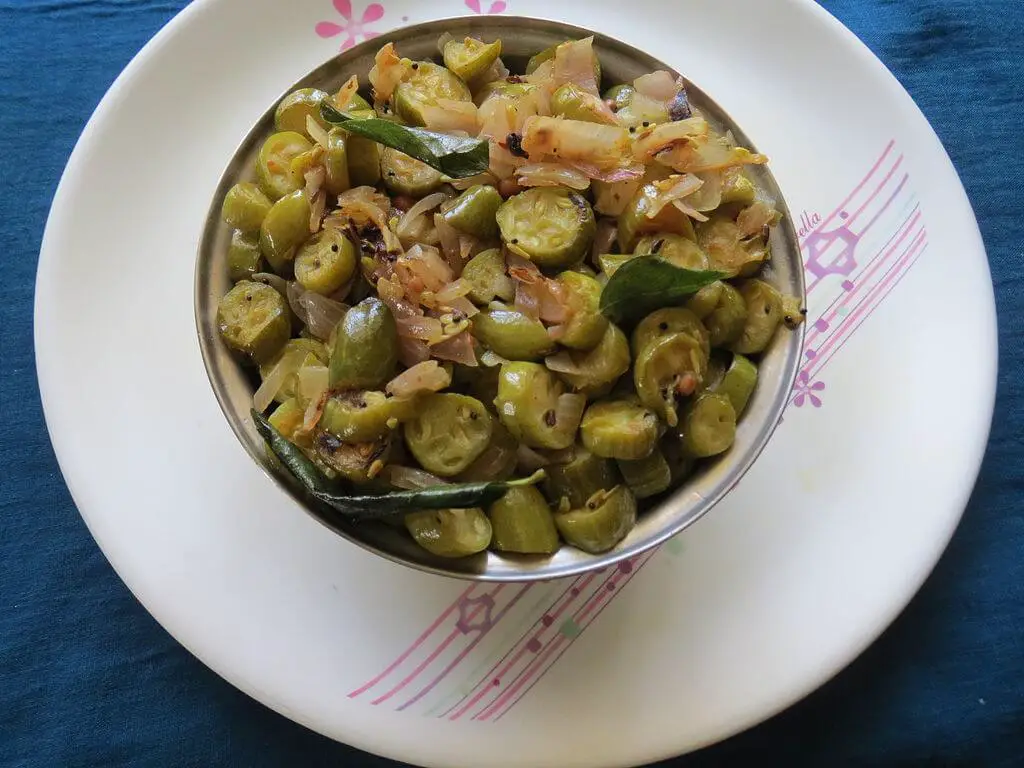
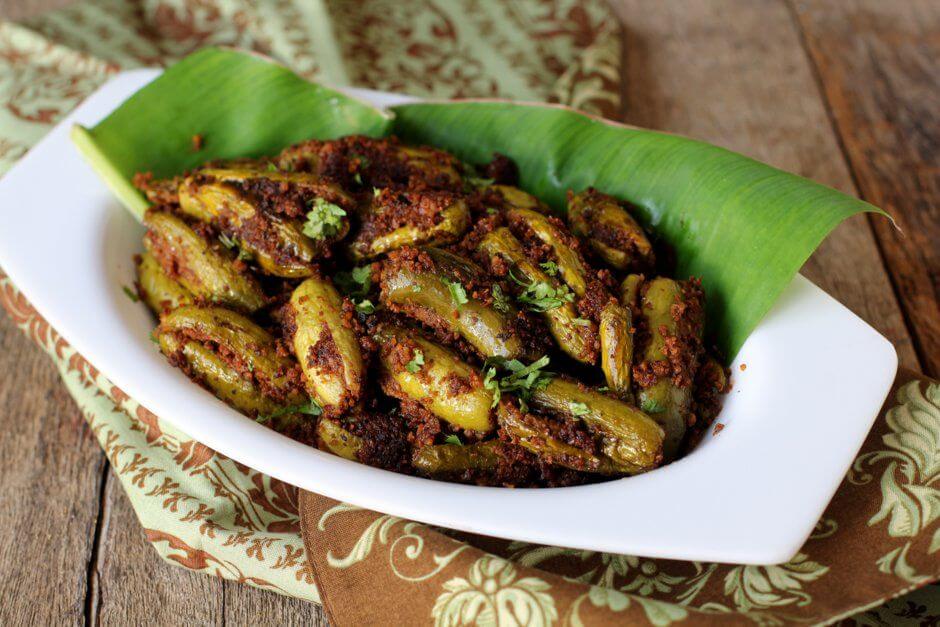
What to read next: Foraging And Cooking Cocoplums
Originally from Florida, but with a lust for travel, Sami has found herself in many remote areas with little-to-no access to traditional medicines. Since 2014, she has been experimenting with natural remedies, eastern medicine, and foraging. She believes that the Earth provides us with everything we need to live, heal, and cure.

